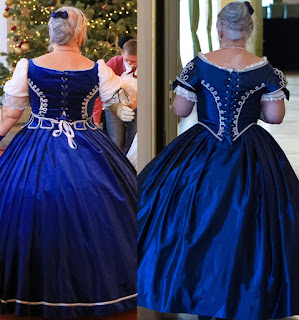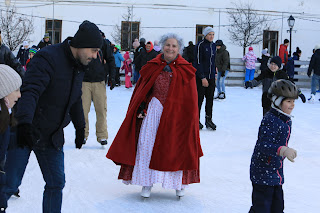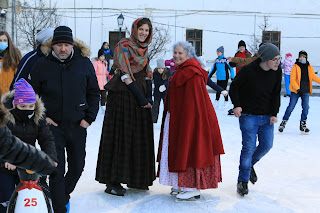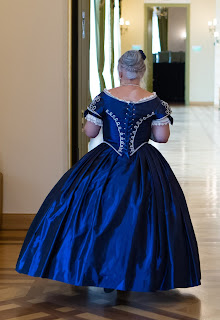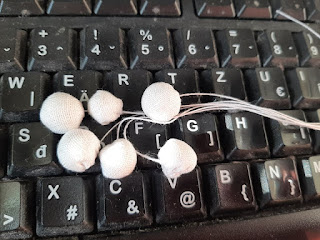Which is not really a court dress, but more like a... kind of difficult to explain, I would say its an upscale version of the Hungarian "folk" dress, but not a folk dress either. There are periods in the Hungarian history, when nationalism flares up, and people want to show their love and support for the country wearing clothing that bears typical Hungarian characteristics, sometimes foreigners wear them to show their support of the Hungarian nation. Like empress Sisi did, when she was crowned as queen of Hungary.
It's basic characteristics, the laced and/or soutached front, the white undershirt, with its lacey sleeves, and the lace apron are the same since the mid 17th century or so, and probably rooted in renaissance dressing. What changes are mostly the shape and undersupport of the skirt, maybe the details, and waistline of the bodice. On this pic there is an 18th century version, in the background, on me a mid 19th century version.
I had such a court dress for a few years now. And I admit I desparately disliked the dress. Most probably its biggest sin is I did not make it. It was made by a young man to show off in the yearly competition of the dressmaker shcool he went to. He asked me to modell it on the competition, I paid for the fabric, its a long story. Anyhow, however talented dressmaker my friend was, the dress, though it looks nice, has a ton of problems.
The bodice is too short, that is why the tabs added (which are actually HA, there are examples of bodices like that), the bodice is totally not finished (at least not to my standard- there are raw edges inside), the boning is missing. The sleeves are unfinished as well, only held up by a freestanding ribbon tied around it, which falls off if I as much as raise my hand.
Also the skirt is way to heavy. We did agreed that it will be made out of three panels, like all the other mid-19th century skirts I did, and I will use the leftover for a day-bodice. He put 4 panels of velvet in the skirt, which made it so heavy, it was really uncomfortable to wear, much less dance in it.
So at the end it turns out I cannot stand the velvet court dress, I did wear it in Gödöllő castle in december, but I took it off almost crying and saying I never going to wear it again. I understand the beauty and the appeal of it, and I thought once, in the future, I will do one for myself that I will wear with pride, but I need to find the right time, the right fabric, etc.
However, as we were getting ready to the event we did at the "Vigadó", which was a building tour spiced with history of the building, the balls that were done in there and customs, stories of balls of the period, we divided the ages amond us. Early Victorian, which is actually the age of reforms for us, mid- Victorian, the 1860, the 1870-ies and the 1890-ies. Since I got the 1860-ies it was obvious that I need to do something about my dress.
I could not wear the Tardisblue-and-roses gown, because in the summer when I last wore it, we saw that I "quarantined out" of it. I can, kind of, lace myself into it, but it fits bad and it is uncomfortable at my current weight. So a new bodice was in plans anyhow, but as we were getting deeper and deeper into the research and the material we had to get through and learn, it became clear that my period was one of the heydays of that type of the Hungarian dress, so much there were articles about it, in fact that a newspaper called Nefelejcs (Forget me not) did an obituary for the french fashion... So a Hungarian court dress was in order. The skirt of my 1860-ies ballgown still fits me, thankfully I could use it, thus I only had to make a new bodice. Also, back then, when I've made it, I bought plenty of the taffeta, so I even had more than enough leftover for the bodice.
I used the same truly Victorian pattern I used for the bodice of the lilac dress, two posts back, only for that I had to use the smallest size and take that down a notch or two, now I had to use a size toward the larger ones.
I did make a mock up, that fit surpisingly well, only the waist and the mid back needed adjusting. Usually I call my friend Tilda to help with fitting, but there was no time for that so I enlisted my son. Now, he is a 20 year old young man, and even though he is used to his mother doing crazy things (and making him do crazy things), still looked a bit quizzically at me, when I handed him a box of pins to pin the thing on me... At the end we found that small safety pins work better for him, and he managed to draw the line on the mid back.
By the time, I needed fitting with the half done final piece Norbi was up, but he is not better than Chris with the pins, but he fought them heroically. and managed to help me out there.
Unfortunately, once again I've went through the sewing concentrating getting it ready in time, and forgot to make photoes of the process, but here are some finished pictures.
With this bodice I was trying to fix some of the issues I had with the other dress.
Like I really wanted to have the dress properly finished. On its inside as well as the outside.
The dress is lined with the flatining technique and I used printed cotton canvas.
The boning channels are made from twill tapes, sewn down either by machine (on the straight front), or by hand everywhere else.
The inside sleeve seam is covered with a bias tape.
Other edges are covered with a wide bias tape on the bottom, or a lining cut to shape around the neck, but all of them is sewn down by hand.
One thing I always do on my laced clothes, that is -again- missing from the velvet dress is a wide flap to go under the lacing, so underwear would not show, even if you cannot lace it thightly shut.
I have spent an inordinate amount of time to sew on the soutache, which also needed to be done by hand, becuse of the boning.
One of those is that I do not like on the velvet dress is the white insert on the front. Or rather its not the white insert I dislike, but the line of the velvet part makes, so I eliminated it. There are plenty of examples with a full front.
The most difficult part wasn't only the miles of handsewing, but also trying to hide away and fixing the edges that frayed like hell, even if I only looked at it.
The white, lacy sleeves are also typical of this type of dress. On the velvet version, there is cotton tulle, however the store I bought it from is closed at the moment, because the owners have Covid. I decided to use the little little sleeve or sleevehead -that can also be seen on a number of pictures - and use a plain white muslin underneath with a lace edging. With this I managed to smuggle an element that I dearly love, the slit sleeves of the renaissance.
Don't ask me why I love those, but even on the prom-dress I made many decades ago, had false slit sleeves. Of course I have it on my renaissance dress, and I have it on my napoleonic/regency ball overgown. Now I have it on this dress too. I also solved the problem of the ribbon and bow, that seems to be a basic element of the sleeves, as they are on every paintings I've seen. I incorporated in a way, that is fixed, sewn on, and would not fall off, even if the bow opens up somehow.
Another thing I've tried to incorporate: roses. Reenactment is a kind of time-travelling... right? Almost by accident (but then again, there are no accidents, right?) my first "real" historical dress was TARDIS blue. What is a better reference in a time travelling hobby, than to the time travelling TV show of all time, Doctor Who? And then it was by no accident that it had been decorated with roses. This dress is still the same blue, so I thought some roses should be on it. I was really happy to find in my stash, the rose shaped buttons to use: not only the big ones for the front, but small ones to use on the sleeves.
Also there was the question of fixing the lacing on the front. Should I just put it around the button? Should I sew them under the soutache? And then as I was sewing on the buttons an idea hit me:
The little ears (shank) of the buttons were big enough to thread the lace through, so that is what I did.
After all, I was done just in time, that after learning my stuff, making my dress, we even could go, and see the first concert of the year by our favorite band.
So here you go, some pictures of the finished dress.
Base pattern: Truly Victorian 442
Detail photos: my phone.


